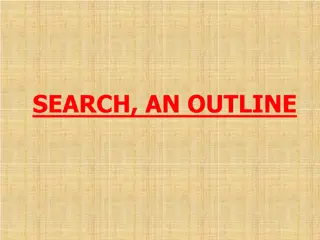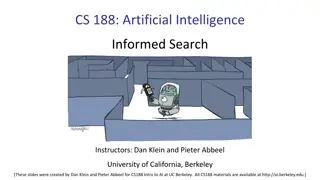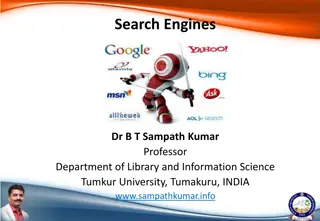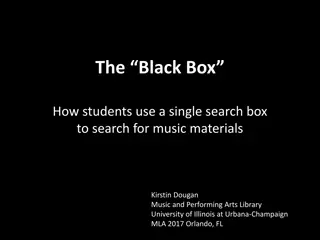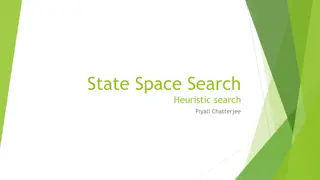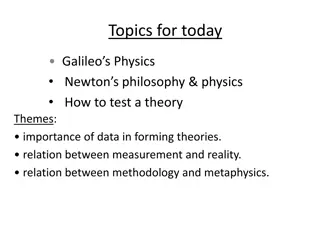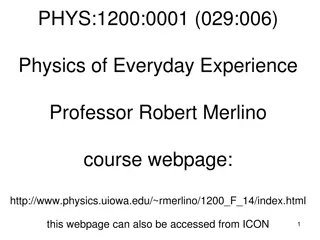Understanding the Search for Ether in Physics
Maxwell's equations in 19th-century physics led to a quest for the elusive ether, a hypothetical medium that could resolve issues of relativity and explain light waves. Physicists sought to detect the ether through experiments like aberration, attempting to observe changes in light direction due to Earth's motion. The existence of ether would challenge Galilean relativity and introduce a fixed reference frame for physics laws. This search for ether provides insights into the historical evolution of physics theories and experimental practices.
Download Presentation

Please find below an Image/Link to download the presentation.
The content on the website is provided AS IS for your information and personal use only. It may not be sold, licensed, or shared on other websites without obtaining consent from the author. Download presentation by click this link. If you encounter any issues during the download, it is possible that the publisher has removed the file from their server.
E N D
Presentation Transcript
Search for the ether HW3 Thursday. Feb 12th. Quiz next Thursday, Feb 20th on relativity: Short answers. 20 mins. Closed book. Materials from Rohrlich pgs.34-88, Cushing Chpts. 13,16-17, Sklar pgs. 25-40 & class notes.
Does the Earth Move? The Problem: Maxwell s equations describing electrodynamics violate Galilean invariance. They contain an absolute (not relative) speed. Consider the wave equation, which describes the motion of radio and light waves (E is the electric field): 2E x2= 2E t2 1 c2 That c is the speed at which the waves move, and its presence in the equation is a not good for Galilean relativity, even though the equation is pretty. Galilean relativity says that if one person observes an object to have a certain velocity another person (who is moving) will observe a different velocity. Maxwell s equations don t seem to accommodate this behavior for light, because the equation doesn t say to use a different c for different observers. How does one try to solve the problem? If one is a late 19th century physicist, the natural guess is that c is the speed relative to the ether, NOT to any old observer.
Why look for the ether? By analogy with the behavior of other waves (e.g., sound and water waves) it was natural to expect light waves ( light means any electromagnetic wave) to be carried by a medium. The ether might transmit other long distance effects, such as gravity, as well. It offered the possibility of a resolution of the Newton-Leibniz (i.e., the substantivalist-relationist) debate. If the ether exists, then it (i.e. relations among its parts) becomes a candidate for Newton s absolute space. (Sklar, Space, Time, & Spacetime, p. 196) If the ether takes over the role of absolute space, there is now just one reference frame in which you can use the simple laws of physics (Maxwell's equations.) Galilean relativity would be out the window. A careful experiment could either verify or falsify Maxwell's equations in the observer's frame, and thus say in a meaningful way if that frame is moving.
How to look for the ether If you are moving through a medium, the observed speed of the wave will vary with direction. The apparent direction of a source will vary with the observer s velocity (aberration, see Rohrlich, p. 53). These effects are not large. The largest speed you have easy access to is the speed of the Earth in its orbit, about 30 km/s, which is about 10-4 c. (rotating around some unknown average velocity)
Searches for the ether: Aberration Rotation is required to let the eyepiece move into the path of the light. v Aberration had been seen in 1674, (Hooke), described in 1728 by Bradley If the telescope (mounted on the earth) moves through the ether, you have to tilt the scope a little so that the rear end is in the right place when the light gets to it. As the Earth goes around the sun, the apparent direction of a star changes by 0.3 minutes of arc. This is only x10 smaller than Tycho could see by eye, and is easily measured with a telescope. Conclusion: The Earth changes its motion through the ether periodically, just as it's supposed to if it orbits a Sun which is not accelerating. (Proof of Copernicus theory?) (Proof of ether idea?) But since we don't independently know which is the "true" position of the stars, we don't know when our telescope is pointed straight at the stars and when it's tilted. We've measured the Earth's velocity changes, i.e. acceleration, but not its velocity relative to the ether.
More key searches for the ether Ether drag. It was known that light moves more slowly through materials which have an index of refraction. So, filling a telescope with water (Fresnel) should have a calculable effect on aberration. (You would have to tilt the telescope a little more, to allow for the longer time-of-flight.) It didn t. Conclusion: The ether is partially dragged along with the moving material: vether=vmatter(1 c'2 c2) where c' is speed of light in the matter.
More key searches for the ether mirrors Hoek's Experiment (1868) Glass rod Light source Half- mirror Velocity of apparatus relative to ether detector At the detector, there are interference stripes between light that went around clockwise and counterclockwise. The position of the stripes is a very sensitive function of the time difference between those two trips, which go in opposite directions through the moving rod. The observation is that the fringes DO NOT SHIFT regardless of the Earth's motion. That again requires that the ether be partially dragged along with the glass, by the same amount that Fresnel claimed.
More key searches for the ether Fizeau's experiment was like Hoek's, except that the rod was replaced with a tube containing water. When the water was flowing, the fringes did shift, in the amount predicted by the partial-ether-drag picture But we still haven't managed to measure the Earth's speed- we just measured the change in velocity of the water (relative to apparatus) when it is flowing, but that's nothing new!
The Searches dont work Something is frustrating: we have all sorts of experiments that fit a theory that says that Maxwell's equations only work in a special frame- but somehow we can't quite measure our motion with respect to that frame, can t even tell if we re at rest in that frame. Even worse, there was a major paradox: Because the index of refraction of the water (or glass) varies with color, the speed of light in these materials varies with the color, so the inferred speed of the ether depended on the color of the light. How could this be? Are there a whole collection of different ethers, for the uncountably infinite possible frequencies of light?
Lorentz fixes a lot H. A. Lorentz resolved all but one of the problems above. if the ether were entirely stationary, the propagation of light would still be affected by the motion of the electrons with which it interacts in the material it's travelling through. He derived from Maxwell's equations how big that effect would be. It gave exactly the Fresnel effect, and thus explained ALL of the experiments above. The medium in which light propagates is actually (ether + electrons, etc.) so "partial ether drag" becomes just "fixed ether + moving electrons." All those experimental results follow naturally from Maxwell's electromagnetism, plus the quantitative theory of how light interacts with the electrons in materials. We don't need separate ethers for each color, just need the simple fact that the electrons scatter an amount of light that depends on color.
But are we moving? So none of these experiments have done anything to measure our absolute motion through the ether, although aberration at least seems to have shown changes in that motion. Why is it so hard to think of an experiment to measure that absolute motion? Is there a serious experiment to measure the absolute motion of the Earth? We need light just propagating in a vacuum, not any of these messy complications due to interactions with moving media. And we need a round- trip, so that we can compare timing of two signals at the same place.
Michelson-Morley Velocity of apparatus wrt ether Light paths in Ether Frame 2 2 2 2 2 = + c t v t L Light paths in Lab Frame 1 L = t vt c 2 v 1 ( ) 2 c L L = + = t + ( 2 ) ( 2 ) c v c v 1 L 2 c v 1 2 c So the time taken on the two round-trip paths is different, depending on which way lines up with the motion through the ether. The fractional change in the time is about v2/c2, or about 10-8 for the earth's orbital speed. But that's comparable to one wavelength of light, if the path L is a few tens of meters.
M-M results If the apparatus is moving through the ether, the interference pattern will shift left or right. This is a very sensitive method, since the wavelength of light is 5*10-7 m. The experiment was supposed to be sensitive enough to detect even the rotation of the Earth (300 m/s) as well as the orbital motion. It didn't. Possible explanations: Complete ether drag: local ether is always at rest with respect to local matter (incompatible with aberration). Speed of light is determined by the source. Ruled out by using the Sun as the interferometer s light source. The apparatus shrinks in one direction as it moves through the ether.
Lorentz-Fitzgerald Contraction (1892) In order for the third explanation to work, the contraction must exactly cancel the expected effect. In technical terms, a conspiracy. The size of the effect is tiny: c() 2 v L L 1 For v = 30 km/s the factor is ~0.999999995 (i.e., 1 5*10-9). Did this make sense? Maybe, because materials are held together by chemical (electrical) forces, so the same thing that affects light might affect materials as well. However, there was no quantitative theory that predicted the contraction. To maintain a consistent picture, clocks which are moving through the ether must also run slowly by the same factor (time dilation). Lorentz also found that it seemed necessary for masses to change as they moved through the ether. These two effects are part of what is called the Lorentz transformation, a set of rules for how things change in moving reference frames. Warning. The interpretation of these effects will soon change .
Ether effects The ether started out as an almost meaningless hypothesis, "the stuff in which light is a wave" or "the stuff which is always at rest in the frame in which Maxwell's equations work". Now to explain experiments, we find that the ether has all sorts of effects on things moving through it Shrinks rods Slows clocks Changes masses. That sounds like a great confirmation of the ether's reality, until you notice that the net effect of all these changes together is that:
The motion through the ether is undetectable! Maxwell's equations seem to work in ANY inertial frame! Lorentz griped that nature was conspiring against us. similar to some other conspiracy theories, in which every absence of a detectable evidence is taken as proof of how deep the conspiracy goes Almost Relativity? In 1904, Poincar suggested that it might be impossible to measure one s speed through the ether. He proposed that "A complete conspiracy is itself a law of nature." He asked, What must be true if one s speed through the ether is to be unobservable? He was able to show that the mass of an object (the m in momentum = mv ) would increase as an object s speed increased. Also, the speed of light would be the maximum possible speed. These conclusions may sound familiar to those of you familiar with Special Relativity. However, there was still an underlying assumption, left over from the first impression made by Maxwell's equations, and perhaps from our Aristotelian instinct, that one reference frame was "right", however hidden it might be.
will the ether frame reveal itself? The principle of physical relativity is an experimental fact ... and as such it is susceptible to constant revision. The principle of relativity thus does not appear to have the rigorous validity which one was tempted to attribute to it. Poincar ,quoted by Holton, p. 205. The situation was unsatisfying from a philosophical point of view to Lorentz and Poincar and others: ...surely this course of inventing special hypotheses for each new experimental result is somewhat artificial. It would be more satisfactory if it were possible to show by means of certain fundamental assumptions ... H.A. Lorentz, quoted by Holton, Thematic Origins of Scientific Thought, p.229. Maybe the principle of relativity should be taken as a postulate, not just a contingent fact. (At least tentatively.) Will that give us anything beyond the description of the phenomena in terms of Lorentz contraction, time dilation, etc.? And what will become of the stellar aberration observations, which seemed to show a direct ether effect?
Stellar Aberration Revisited Although none of the experiments managed to find an absolute velocity, remember that stellar aberration found evidence of CHANGES in our velocity "with respect to the ether." We can't just abandon the ether hypothesis unless we can still account for stellar aberration. Relativistic interpretation: treat the Earth as stationary NOW. In this frame, the star is moving. The star's velocity is opposite to the conventional velocity of the Earth in a Sun frame. You have to point your telescope back toward where the star was when it emitted the light. That requires a tilt of v/c. NOW THEN THEN NOW In 6 months, you use a different frame (the Earth has changed its motion) and in the new frame, the star is moving the other way, so you point your scope back the other way. We assume that the acceleration is small enough that it has no direct effects. The net observed effect is identical to the "stationary ether" prediction- but without the hypothesis of a particular special reference frame!
Einstein's approach Initially motivated by Mach s conception of a completely relationist universe. (For Mach, even acceleration was relative.) Precursors to special relativity retained the notion of absolute space in the guise of the ether. For Poincar the ether had become as undetectable as Newton s absolute space. This was unsatisfying to Einstein. Why does one use one equation to describe a conductor moving past a magnet and another to describe a magnet moving past a conductor? It is known that Maxwell s electrodynamics as usually understood at the present time when applied to moving bodies, leads to asymmetries which do not appear to be inherent in the phenomena. Einstein, On the Electrodynamics of Moving Bodies, Annalen der Physik, 17 (1905). Einstein: "The phenomena of electrodynamics as well as of mechanics possess no properties corresponding to the idea of absolute rest. The same laws ... will be valid for all frames of reference." That postulate (relativity) sounds familiar, but how can we combine it with Maxwell's equations?
Einsteins two Postulates 1. If, relative to K, K is a uniformly moving coordinate system devoid of rotation, then natural phenomena run their course with respect to K according to the same general laws as with respect to K. This statement is called the principle of relativity (in the restricted sense). Einstein, Relativity, p. 16. This principle applies to all phenomena (including electrical and optical), not merely mechanical. So, what to do about Maxwell s equations? We accept them: 2. electromagnetic phenomena, of which the law of constancy of the velocity of light in vacuo is a necessary consequence. p. 23. The insistence that these two "apparently incompatible" principles are consistent is the new idea. ... experience in this domain leads conclusively to a theory of Let's see more carefully why these two ideas seem inconsistent- the worst thing you can do is to simply accept them without drawing the necessary consequences. NEXT TIME






